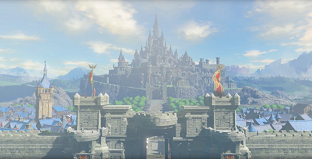Related Research Articles

The Legend of Zelda is a video game franchise created by Japanese video game designers Shigeru Miyamoto and Takashi Tezuka and mainly developed and published by Nintendo. The universe of the Legend of Zelda series consists of various lands, the most predominant being Hyrule. The franchise is set within a fantasy world reminiscent of medieval Europe which consists of several recurring locations, races and creatures. The most prominent race in the series are the Hylians, a humanoid race with elfin features identifiable by their long, pointed ears. The series' lore contains a creation myth, several fictional alphabets, the most prominent being Hylian, and a fictional universal currency, the rupee. Most games in The Legend of Zelda series follow a similar storyline, which involves the protagonist Link battling monsters to save Princess Zelda and defeat a villain, which is often the series' main antagonist, Ganon. Nintendo developed the series' lore into a timeline that spans thousands of years across its history.

The Legend of Zelda: Majora's Mask is a 2000 action-adventure game developed and published by Nintendo for the Nintendo 64. It was the second The Legend of Zelda game to use 3D graphics, following Ocarina of Time (1998). Designed by a creative team led by Eiji Aonuma, Yoshiaki Koizumi, and Shigeru Miyamoto, Majora's Mask was completed in less than two years. It featured enhanced graphics and several gameplay changes, but reused a number of elements and character models, which the game's creators called a creative decision made necessary by time constraints.

Fallout is a media franchise of post-apocalyptic role-playing video games—and later action role-playing games—created by Tim Cain, at Interplay Entertainment. The series is set during the 21st, 22nd and 23rd centuries, and its atompunk retrofuturistic setting and art work are influenced by the post-war culture of 1950s United States, with its combination of hope for the promises of technology and the lurking fear of nuclear annihilation. A forerunner of Fallout is Wasteland, a 1988 game developed by Interplay Productions to which the series is regarded as a spiritual successor.
A warp, also known as a portal or teleporter, is an element in video game design that allows a player character instant travel between two locations or levels. Specific area that allow such travel is referred to as warp zone. A warp zone might be a secret passage, accessible only to players capable of finding it, but they are also commonly used as a primary mean of travel in certain games. Warps might be deliberately installed within puzzles, be used to avoid danger in sections of a game that have been previously accomplished, be something a player can abuse for cheating, or be used as a punishment to a player straying from the "correct" path.
The Legend of Zelda: The Minish Cap is an action-adventure game and the twelfth entry in The Legend of Zelda series. Developed by Capcom and Flagship, with Nintendo overseeing the development process, The Minish Cap was released for the Game Boy Advance in Japan and Europe in 2004 and in North America and Australia the following year.
Lesbian, gay, bisexual, and transgender (LGBT) characters have been depicted in video games since the 1980s. Throughout the history of video games, LGBT characters have been almost nonexistent for a long time, reflecting the overall heteronormativity of the medium. While there has been a trend towards greater representation of LGBT people in video games, they are frequently identified as LGBT in secondary material, such as comics, rather than in the games themselves. Often, LGBT characters and themes, when they are included, are underrepresented, minimized, or watered down. Queer games and characters have also often found themselves being the subjects of cultural crossfires or moral panics. In 2018, Sam Greer of Gamesradar+ found only 179 games commercially released games with any LGBT representation, only 83 of which have queer characters who are playable characters, and only 8 of those games feature a main character who is pre-written as queer as opposed to them being queer as an option.

Health is a video game or tabletop game quality that determines the maximum amount of damage or fatigue something takes before leaving the main game. In role-playing games, this typically takes the form of hit points (HP), a numerical attribute representing the health of a character or object. The game character can be a player character, a boss, or a mob. Health can also be attributed to destructible elements of the game environment or inanimate objects such as vehicles and their individual parts. In video games, health is often represented by visual elements such as a numerical fraction, a health bar or a series of small icons, though it may also be represented acoustically, such as through a character's heartbeat.

Navi is a fictional fairy who acts as series protagonist Link's navigator throughout the 1998 Nintendo 64 video game The Legend of Zelda: Ocarina of Time. She was voiced by Kaori Mizuhashi. Navi performs a variety of functions within the game, including being a companion and guide to Link, providing the player with advice and being a focal point for the game's Z-lock targeting combat system. Other characters in The Legend of Zelda series have served in similar roles, including Tatl, Midna, and Fi. When designing the reticle for the game, designer Yoshiaki Koizumi made a ball of light with wings, naming it "Fairy Navigation System" before naming it Navi. She has been widely criticised by players and critics for her repetitive interruptions in gameplay, particularly with the prompt "Hey! Listen!", though some have argued that she was a valuable companion in the game.

A loading screen is a screen shown by a computer program, very often a video game, while the program is loading or initializing.

The Legend of Zelda: Breath of the Wild is a 2017 action-adventure game developed and published by Nintendo for the Nintendo Switch and Wii U. Set at the end of the Zelda timeline, the player controls an amnesiac Link as he sets out to save Princess Zelda and prevent Calamity Ganon from destroying the world. Players explore the open world of Hyrule while they collect items and complete objectives such as puzzles or side quests. Breath of the Wild's world is unstructured and encourages exploration and experimentation; the story can be completed in a nonlinear fashion.
Teleportation is the theoretical transfer of matter and/or energy from one point to another without traversing the physical space between them. It is a common subject in science fiction and fantasy literature, film, video games, and television. In some situations, teleporting is presented as time traveling across space.

FTL: Faster Than Light is a real-time strategy roguelite game created by indie developer Subset Games, which was released for Microsoft Windows, macOS and Linux in September 2012. In the game, the player controls the crew of a single spacecraft, holding critical information to be delivered to an allied fleet, while being pursued by a large rebel fleet. The player must guide the spacecraft through eight sectors, each with planetary systems and events procedurally generated in a roguelike fashion, while facing rebel and other hostile forces, recruiting new crew, and outfitting and upgrading their ship. Combat takes place in pausable real time, and if the ship is destroyed or all of its crew lost, the game ends, forcing the player to restart with a new ship.

Cube World is an action role-playing game developed and published by Picroma for Microsoft Windows. Wolfram von Funck, the game's designer, began developing the game in June 2011, and was later joined by his wife, Sarah. An alpha version of the game was released on July 2, 2013, but saw sparse updates and communication from von Funck, with many considering the game to be vaporware until he officially released it on September 30, 2019.
The study of religion and video games is a subfield of digital religion, which the American scholar of communication, Heidi Campbell, defines as "Religion that is constituted in new ways through digital media and cultures.". Video games once struggled for legitimacy as a cultural product, today, however, they are both business and art. Video games increasingly turn to religion not just as ornament but as core elements of their video game design and play. Games involve moral decision, rely on invented religions, and allow users to create and experience virtual religious spaces. As one of the newest forms of entertainment, however, there is often controversy and moral panic when video games engage religion, for instance, in Insomniac Games' use of the Manchester Cathedral in Resistance: Fall of Man. Concepts and elements of contemporary and ancient religions appear in video games in various ways: places of worship are a part of the gameplay of real-time strategy games like Age of Empires; narratively, games sometimes borrow themes from religious traditions like in Mass Effect 2.

Sif, the Great Grey Wolf is a character and boss in the 2011 action role-playing game Dark Souls. A wolf that has grown to a massive size, it protects the grave of its deceased master, Knight Artorias the Abysswalker, and the Covenant of Artorias, a ring that allows its wearer to traverse the Abyss, a dark void normally impassable by mortals. The fight with Sif has been cited by critics as one of the most memorable in the game due to the role reversal of the player as a transgressor. Sif also functions as an optional ally in the game's DLC.

Endless Express is a first-person simulation video game developed in 2014 by Florian Veltman, Alexandre Taillefert, Martin Gugger, Felix Meunier, and Baptiste Virot. The game was first created as part of a 7-day game jam, but was later "reimagined" and re-titled "The Endless Express" in 2016, however, the project was discontinued, with its work-in-progress build publicly released. Endless Express was released on Microsoft Windows, MacOS, and Linux systems.

Fallout 76 is a 2018 action role-playing video game developed by Bethesda Game Studios and published by Bethesda Softworks. It is an installment in the Fallout series and a prequel to previous entries. Set in the year 2102, players control a resident of Vault 76 who must venture out into the dilapidated open world known as "Appalachia" in order to re-colonize the region, and uncover a mysterious plague that has killed off its inhabitants. Fallout 76 is Bethesda Game Studios's first multiplayer game; Bethesda developed the game using a modified version of its Creation Engine, which allowed the accommodation of multiplayer gameplay and a more detailed game world than in previous games.
Zfg is an American speedrunner and streamer known for his The Legend of Zelda: Ocarina of Time gameplay. He has held various records in speedrunning the game and its alternative version Master Quest, most notably the 100% completion category for the original game, for which he had held the record since mid-2015. He was the first person to complete Ocarina of Time to 100% in under four hours. He currently holds the record in the 100% SRM category with a time of 3 hours, 0 minutes, and 39 seconds, as of December 2022.

Dujanah is an art video game developed and published by Jack King-Spooner, a Scottish indie game developer. It was released on September 19, 2017. The game follows Dujanah, a Muslim woman in a fictional country under the occupation of foreign powers in a stylized magic realist–style world as she tries to find out what happened to her husband and daughter. The game focuses on the theme of death, and explores it through the stories of people that Dujanah meets as she walks through her country. Reception to Dujanah was positive, with praise focused on its themes and storytelling.
A Soulslike is a subgenre of action role-playing games known for high levels of difficulty and emphasis on environmental storytelling, typically in a dark fantasy setting. It had its origin in Demon's Souls and the Dark Souls series by FromSoftware, the themes and mechanics of which directly inspired several other games. Soulslike games developed by FromSoftware themselves have been specifically referred to as Soulsborne games, a portmanteau of Souls and Bloodborne. The "Soulslike" name has been adopted by a number of critics and developers. However, there have also been questions whether it is a true genre or a collection of shared mechanics.
References
- 1 2 "Does fast travel help or hurt games?". GameCrate. 2015-02-14. Archived from the original on 2015-02-14. Retrieved 2018-02-26.
- 1 2 3 "Journeys In Games: Let's Talk About Fast Travel". Rock, Paper, Shotgun. 2015-06-26. Retrieved 2018-02-26.
- ↑ Hernandez, Patricia. "You Should Try Fallout 4 Without Fast Travel". Kotaku. Retrieved 2018-02-26.
- ↑ Hamilton, Kirk. "If You're Playing Zelda, Try Fast Traveling Less". Kotaku. Retrieved 2018-02-26.